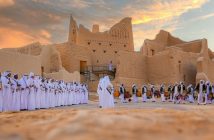Israeli cooking, certainly in London, has been very much in vogue of late, with restaurants like the Palomar getting rave reviews, and the ubiquitous Yotam Ottolenghi doing the rounds. But I never would have imagined that Akko with its focus on the dust and stone of history would have had the wherewithal to offer its culture sleuths anything more than the basic nourishment to totter from one archaeological dig to another.
How wrong I was. Indeed the Uri Buri is an unremarkable looking place. Built into the stone remains of a much older building, the ancient window apertures have been transfixed by hideous aluminium things which, on the day we visited, peeped forlornly out at a promenade as dismal as a February afternoon in Margate. Inside it was not extensive, consisting of two rooms hung with coloured woven draperies, one of which contained a bar nestled in the corner. But what did Grandma used to say? Never judge a book by its cover.

At this point the most interesting thing about the place was a figure leaning over a table talking to a group of lunchtime diners. He was a big man – tall and fleshy with great stooping shoulders and a large paunch. When he moved it was with the elegant gait of a mastodon’s amble. He had a big shaggy head but his most striking feature was his beard, white and shaped like an arrow head and growing down nearly to his naval. Such was the impression that when he sat down with us I half expected him to deposit a couple of stone tablets on the table.
This was Uri Jeremais, the owner and creator of the restaurant and the nearby Efendi Hotel, an exquisite restoration and combination of two stately Ottoman palaces which does for the eye what his cooking was to do for my stomach. He talked in a soft murmur and it was soon clear that his character was as one off as his appearance. He had done many things in his life, including a stint with the United Nations, and it was through extensive bouts of globe trotting that he was to savour and develop his feel for flavour in food and the essential nature of raw ingredients.

When the food started to arrive – and we must have clocked up five or six courses – it quickly became apparent that this was no ordinary restaurant. The food was divine and was put together by someone who loved and understood it on many levels. Most tellingly was that he respected it and this respect was honoured by the food giving up some of its deep secrets. It was on a par with Raymond Blanc’s Le Manoir aux Quat ’Saisons; superior in fact, as it lacked the fussiness of that place. The food seemd more real here somehow. Destination restaurant indeed.
I asked him, if, when he discovered cooking (and he is entirely self taught) he had finally found his calling. His answer was unexpected but as refreshing as his seafood; “I change things when I get bored. I never stay at a job when it has ceased to hold my interest. The only thing I have not changed in the last fifty years is my wife!”

It is well known that Israel and Jerusalem in particular, is counted as a holy place for the three main Abrahamic religions of Judaism, Christianity and Islam. What is not so well documented – at least I was ignorant of this fact – is that it holds special significance for another of the world religions, the Bahá’í faith. And interestingly it is not Jerusalem that is the spiritual focus, but Akko.
The religion was founded in Persia, as Iran was then called, by Mírzá Ḥusayn-`Alí Núrí or Bahá’u’lláh as he later became. It was an outgrowth of Bábism, itself an off-shoot of Islam, which flowered in the first half of the nineteenth century. The Bahá’í faith has a modern, humanistic flavor befitting its modern inception, believing in the unity of God, of religion and of mankind, that we are all linked in a sort of vast, cosmic jigsaw. Humanity and religion are seen as constantly evolving and that Buddha, Jesus and Mohammed have all been messengers of God’s word, the Báb (the head of Bábism) and Bahá’u’lláh being the most recent. In some ways it feels as though it has adopted the peace and love affirming bits from Christianity and Islam with a dollop of the Buddhist emphasis on self development and spiritual growth.
It was not long before Bahá’u’lláh’s gentle espousals of peace and brotherly love had aroused the anger of the ruling Muslim clerics and Qajar princes. (To this day the Bahá’í faith is seen as apostasy in some Muslim countries and its adherents persecuted.) After the Báb (the head of Bábism) was executed in 1850 and most of his followers killed, Bahá’u’lláh went into exile in the Ottoman Empire, first travelling to Baghdad, then to Constantinople, and finally Acre, where he was imprisoned as a suspected agitator. In fact he was to spend his final years as a political prisoner although by this stage the quietude of his character had convinced the authorities that he posed no threat. He had a certain freedom of movement, residing in the Mansion of Bahji outside the town. Here he devoted his time to writing and corresponding with his followers who were beginning to spread around the world.

When Bahá’u’lláh (literally Glory of God) died, he was buried in a shrine adjoining this mansion. Set in expansive and zealously manicured gardens the place has become one of the holiest for the Bahá’ís and a site of world pilgrimage. The shrine itself is essentially a fairly modest house consisting of several rooms decked out in fine Persian carpets but otherwise unadorned. I recognised it as resembling a well-to-do Iranian’s house where status is indicated by the number and quality of carpets on display. One removes one’s shoes before entering and observe a respectful silence throughout a visit.
Outside, the gardens spread out from this point in a wedged segment, like a quarter of a pie, with red gravel paths radiating out to a periphery wall like rays from the sun. Here a line of pencil cypresses flank the wall, alternating with white urns containing flowers. Between the walkways are laid immaculate green lawns and set in these, advancing from wall to shrine, are flowerbeds with entirely red blooms, laid as eight pointed stars which is the symbol holy to the faith. The geometric design of the gardens is a classic Persian concept and is based on the formal Paradise Gardens which developed under the Achaemenid kings more than two and a half thousand years ago.

Walls were used to demarcate the wildness and aridity of the outside, and a rectilinear theme of paths and planting was employed which normally included long waterways and fountains, echoing the rivers of the Garden of Eden. Such was the influence of the Paradise Garden that many of its elements were incorporated into both Islamic and European garden design and can be seen in places as geographically disparate as the Taj Mahal, the Moorish courtyards and arcades of Andalucia and at the Palace of Versailles.
An even more dramatic example that we saw were the Bahá’í Terraces or the Hanging Gardens of Haifa which descend Mount Carmel (a holy place associated with the prophet Elijah) to the outskirts of Haifa, in nine concentric circles over eighteen terraces, to the golden domed Shrine of the Báb. As with other Paradise Gardens, water plays an important role, both as a natural feature, cascading down beside the steps in twin streams and also in the state of the art irrigation system, computer controlled, which distributes water at night through hundreds of valves according to the meteorological data it receives.
Harry’s odyssey in Acre concludes next weekend as he drives into the hills to meet Israel’s minority groups, the Bedouin and the Druze, and encounters that emblematic rite of passage, the kibbutz…




